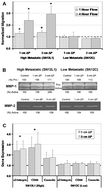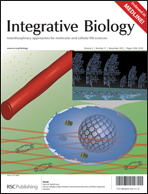Cancer cell glycocalyx mediates mechanotransduction and flow-regulated invasion†
Abstract
Mammalian cells are covered by a surface proteoglycan (glycocalyx) layer, and it is known that blood vessel-lining endothelial cells use the glycocalyx to sense and transduce the shearing forces of blood flow into intracellular signals. Tumor cells in vivo are exposed to forces from interstitial fluid flow that may affect metastatic potential but are not reproduced by most in vitro cell motility assays. We hypothesized that glycocalyx-mediated mechanotransduction of interstitial flow shear stress is an un-recognized factor that can significantly enhance metastatic cell motility and play a role in augmentation of invasion. Involvement of MMP levels, cell adhesion molecules (CD44, α3 integrin), and glycocalyx components (heparan sulfate and hyaluronan) was investigated in a cell/collagen gel suspension model designed to mimic the interstitial flow microenvironment. Physiological levels of flow upregulated MMP levels and enhanced the motility of metastatic cells. Blocking the flow-enhanced expression of MMP activity or adhesion molecules (CD44 and integrins) resulted in blocking the flow-enhanced migratory activity. The presence of a glycocalyx-like layer was verified around tumor cells, and the degradation of this layer by hyaluronidase and heparinase blocked the flow-regulated invasion. This study shows for the first time that interstitial flow enhancement of metastatic cell motility can be mediated by the cell surface glycocalyx – a potential target for therapeutics.


 Please wait while we load your content...
Please wait while we load your content...